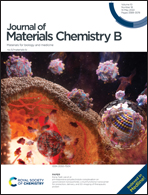Chitosan-based double cross-linked ionic hydrogels as a strain and pressure sensor with broad strain-range and high sensitivity†
Abstract
A conductive hydrogel P(AAm-co-AA)/CS-Fe3+ with double cross-linked networks was fabricated using a one-step polymerization by UV irradiation and a soaking process in Fe(NO3)3 solution. In this hydrogel, the rigid chain of chitosan (CS) and the soft chain of copolymer P(AAm-co-AA) with acrylic acid (AA) and acrylamide (AAm) act as the backbone, among which large amounts of hydrogen bonds are formed by the amino, hydroxyl, and carboxyl groups on the two polymers. Ferric irons (Fe3+) are introduced and form coordination interactions with carboxyl and amino groups of the polymers. The double cross-linked interactions in the system can enhance the tensile strength and toughness of the hydrogel. Thus, the prepared P(AAm-co-AA)/CS-Fe3+ hybrid network hydrogel shows excellent mechanical properties in many aspects: a strength of up to 550 kPa, a broad strain-range up to 800%, fast self-recovery ability (30 min), and low hysteresis strain (<100%). The conductive hydrogel demonstrates high strain sensitivity (gauge factor (GF) = 6.6 at a strain of 700%) as a flexible sensor. Human movements (for example, finger bending, vocal cord vibration, and other human activities) can be sensitively detected using the P(AAm-co-AA)/CS-Fe3+ hydrogel sensor.



 Please wait while we load your content...
Please wait while we load your content...